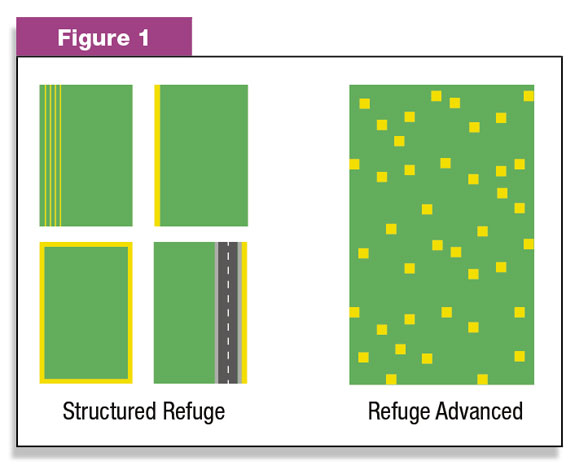Protection from rootworm damage helps keep plants healthy and standing through harvest, especially with silage grown in a corn-after-corn growing environment.
Planting hybrids with insect protection traits is one way for silage growers to control corn pests.These hybrids are genetically modified to contain a gene from the soil bacterium Bacillus thuringiensis (Bt), which controls common corn pests like European corn borer and corn rootworm.
Seed companies now offer many choices of Bt traits in hybrids that are specifically adapted for silage production.
But utilizing hybrids with insect protection traits comes with grower responsibility to adhere to refuge requirements.
Why plant a refuge?
The U.S. Environmental Protection Agency (EPA) requires growers using Bt products to plant a structured refuge area with a specified percentage of non-traited hybrids.
The goal of the refuge is to prevent insect populations from developing resistance to Bt proteins. The refuge acres provide an area for target pests to feed and reproduce without exposure to the trait.
Any potentially resistant insects then have an opportunity to mate with susceptible insects and prevent resistance from developing.
For first-generation Bt traits that contain a single mode of action for insect control, the refuge requirement is 20 percent in the Corn Belt and 50 percent in cotton-growing areas.
Widespread grower adoption of Bt hybrids has increased the number of acres where targeted insects are exposed to Bt proteins.
This increases the importance of growers implementing an Insect Resistance Management (IRM) plan that includes adherence to EPA requirements for refuge acres.
Before planting the seed, growers are required to sign a grower agreement that outlines the required IRM plan.
Adhering to an IRM plan is important for several reasons. If IRM requirements are not met, growers risk losing the technology’s performance if insects become resistant to the technology.
Being a good steward of the technology has a long-term impact on future generations of growers and their ability to use and benefit from insect control technologies.
If insect resistance becomes a problem for one grower, it eventually becomes a problem for other growers.
Tips for refuge management
Many corn silage growers may be puzzled when it comes to managing refuge requirements in their fields.

Traditional refuge can be structured in a number of ways, but the non-traited seed must be grouped in rows of four or more to form a complete block and must undergo the same cultural practices as the traited corn (see Figure 1).
That means a grower planting traited seed in a corn-after-corn system must also plant the refuge in corn after corn.
To help growers plan their refuge acres, the National Corn Growers Association offers an IRM calculator.
This tool illustrates appropriate refuge areas and helps growers determine how much traited and refuge seed to purchase. The tool further explains the possible planting configurations for planting traited corn products across the U.S.
When planning refuge acres, corn silage growers should consider how silage will be harvested, stored and fed.
If the refuge is being planted in a block in the same field and will be chopped at the same time as the traited corn, it’s important to select hybrids with similar maturity and agronomic characteristics.
Traited and non-traited hybrids must be at similar moisture levels at harvest and have similar feed values for optimum dry matter intake.
If a grower plants the refuge in an adjacent field, the refuge seed need not be a silage hybrid, but could instead be a hybrid that’s harvested for grain corn.
New refuge options
Over the past few years, seed companies have introduced products that either reduce refuge requirement, or incorporate the refuge into the bag so no separate structured refuge is required (Figure 1).
For example, SmartStax®, jointly developed by Dow AgroSciences and Monsanto, contains multiple modes of action for controlling both above- and below-ground pests, reducing the structured refuge requirement from 20 percent down to 5 percent in the Corn Belt.
Whether you are utilizing first- generation Bt traits or the newest refuge-in-the-bag technology, be sure to follow all refuge requirements in your silage fields. Consult your seed supplier or agronomic adviser with any questions about setting up an IRM plan. FG











